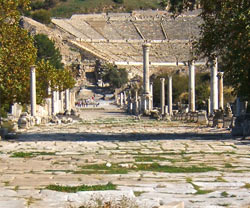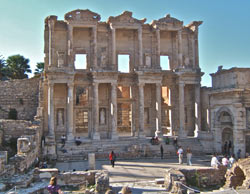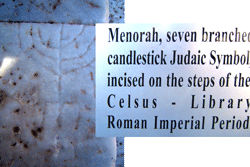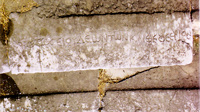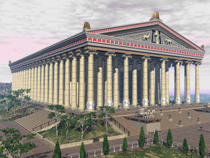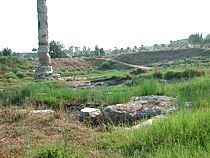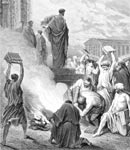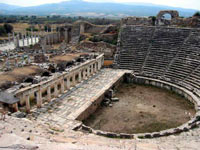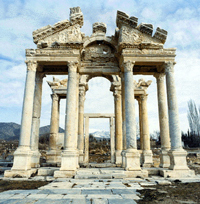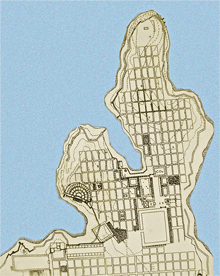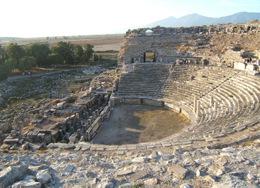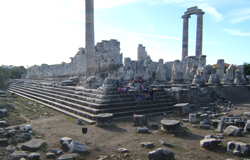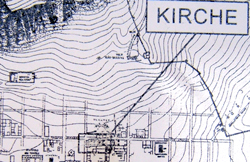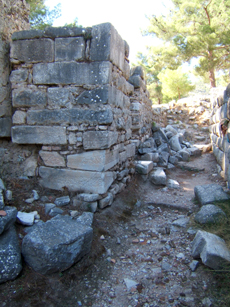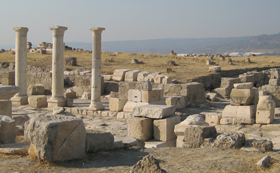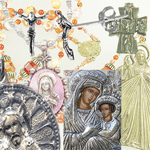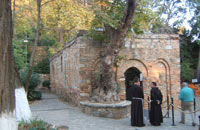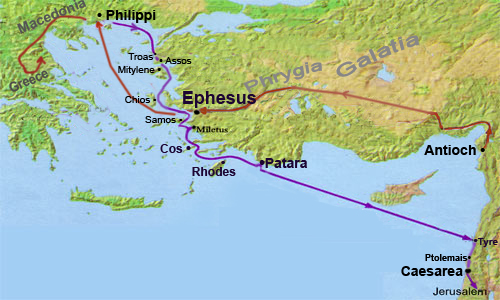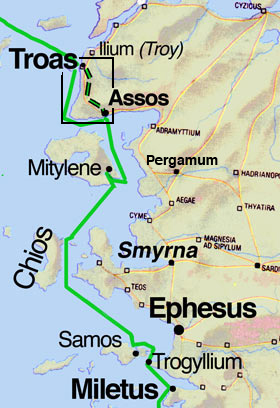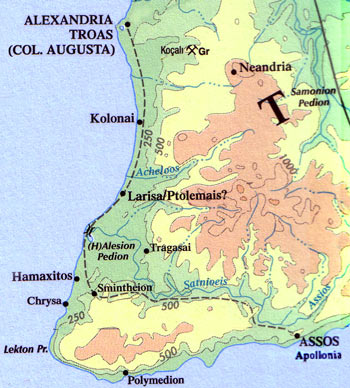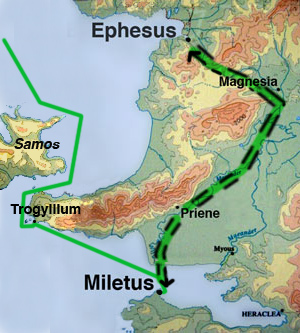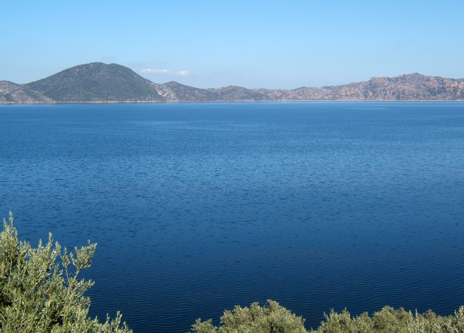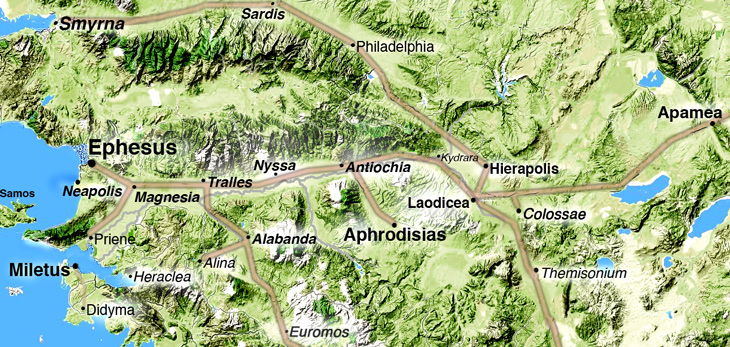The Great Theatre, Ephesus
Harbour street Ephesus, leading to the Great Theatre and centre of town.
The marble-paved street In its heyday had been lined with pillared arcades and illuminated at night. Around 300,000 people lived in Ephesus in the mid-1st century.
Did a Jewish evangelist called Paul really turn this sophisticated city upside down?
Supposedly "the whole city was filled with confusion ... rushed with one accord into the theatre ... and the more part knew not wherefore they were come together ... all with one voice about the space of two hours cried out, Great is Diana of the Ephesians." - Acts 19.29-34
Fat chance.
3rd Mission in about 100 words?
"After he had spent some time there [Caesarea], he departed and went over the region of Galatia and Phrygia in order, strengthening all the disciples ... Paul, having passed through the upper regions, came to Ephesus ... In the synagogue he spoke boldly for three months disputing ... then daily in the school of Tyrannus. And continued by the space of two years, so that all they which dwelt in Asia heard the word of the Lord Jesus, both Jews and Greeks ... After the uproar had ceased, Paul called the disciples to himself, embraced them, and departed to go to Macedonia. Now when he had gone over that region and encouraged them with many words, he came to Greece and stayed three months."
– Acts 18.23 - 20.3
Evidence of Jews in Ephesus – Graffiti! Wow!
The spectacular library of Celsus, Ephesus.
No evidence of a synagogue has ever been found in this vibrant pagan metropolis – but scratched into one of the marble steps of the library is a Jewish-style candlestick.
With such scant evidence of Judaism, did Paul really "speak boldly for three months" in a synagogue in Ephesus?
Assimilating Jews of Miletus
From the theatre at Miletus: On the fifth row of seats are the words, in Greek: "For the Jews and the God-fearers".
Evidence in stone that the Jews were assimilating into Roman-Hellenic culture.
Artemision
The great attraction of Ephesus for pilgrims was the Artemision, one of the seven wonders of the world.
John Chrysostom, Patriarch of Constantinople, commissioned fanatical monks to destroy the sanctuary in the early 5th century.
The Darkness starts here
Acts 19.19. Paul officiates at the burning of books at Ephesus.
The apostle had filled "all the Jews and Greeks with fear" (Acts 19.17) and delighted the simple-minded by handing out handkerchiefs that "expelled evil spirits" (Acts 19.12).
All a fiction – but it set the tone for the centuries that lay ahead.
Aphrodisias – Magnificent city of marble, victim of Christianity
Named for the goddess of love, Aphrodisias had a population of 150,000 as early as the 2nd century BC. In the imperial age the city was one of the leading centers of architecture, art, and sculpture. Its theatre was larger even than that of Ephesus.
The triumph of Christianity was a disaster for Aphrodisias. The Christians ended the market for classical sculpture and renamed the defiantly pagan city "Stavropolis", City of the Cross. Terminal decline followed,
Miletus – a peninsula city
Miletus occupied a peninsula in the "time of Paul". The busy port had harbours on both sides of its peninsula.
A Sacred Way more than 100 feet wide led from the city for 12 miles to Didyma, a sanctuary-city famous throughout the known world for its oracle.
Each year inhabitants and pilgrims followed the sacred route to the Temple of Apollo.
The harbour theatre, Miletus
Beyond the tree line is a fertile plain. In antiquity it was the sea.
Oracle of Apollo
Majestic ruins of Temple of Apollo, Didyma
Apollo and Artemis were said to be twins born to Zeus and Leto. Augustus was one of many emperors to visit the sanctuary.
Oracular utterances were the "words of the Lord" – in this case, Lord Apollo.
The apostle Paul seems not to have noticed this world-famous pilgrimage site.
Perhaps he was too busy handing out hankies to "all of Asia".
Ancient Priene – vandalised by Christians
In the 5th century this crudely built "Bishop's Church" displaced the bathhouse. The building ignored the ancient alignment of streets and – as seen here – reduced the Roman road to a narrow alleyway. Welcome to the Dark Age.
Self -financing Laodicea
Laodicea had its own bank and mint.
"One of the famous cities of Asia, Laodicea, was that same year overthrown by an earthquake, and, without any relief from us, recovered itself by its own resources." – Tacitus (14:27)
"Laodicea. Although Paul mentions the church there, there is no record that he visited it."
– Rudwick, Hemer (Bible Places, p194)
Paul's preaching – a threat to trinkets? No kidding!
House of Mary Mother of Jesus at Ephesus?
Behold, the lack of references to JC's Mother!
Mary has a house on a mountaintop near Ephesus (yes, you can visit it!). Apparently, it was built by the apostle John.
Paul lived three years in Ephesus and nether he nor his "biographer" Luke mentions either Mary or John.
So which part of this is rubbish?
|
Acts of the Apostles, together with Eusebius' History of the Church – the primary documents of early church history – present a fake history, crafted to tell an uplifting story of how "The Way", a marginal sect within Judaism, became "The Church", a universal brotherhood of Christian fellowships spread far and wide. The pivotal figure in this glorious revolution was purportedly the apostle Paul and the climax to the story has the superlative missionary raising the glorious banner of Christ in Rome itself. Yet for all the heroics that fill the pages of the authorized story, the reports of Paul's "evangelisation" of vast areas of the eastern Roman Empire are a triumph of brevity. This is especially true of Paul's third missionary journey. Around a scant one hundred and thirty words are all that we have for the great mission, that and a few curious, quite surreal, tales. The first relates to a group rebaptism.
Strange happenings in Ephesus Paul was "forbidden" by the Holy Spirit to enter the Roman province of Asia on his second missionary journey (Acts 16.6) which makes it all the more curious that he faced NO such prohibition on his third journey only a few years later. What on earth could the Holy Ghost have been thinking? In Paul's absence, rivals have been active. It seems that on arrival in Ephesus, Paul finds twelve male disciples – well, it would have to be 12, wouldn't it? – who had received only the "baptism of John". Alarmingly, they had "not so much as heard of" any Holy Ghost. Fancy that. Just whose disciples are they then? Paul tells them that they need to be baptized in the name of the Lord Jesus, the magic incantation. This they do without a word of argument, and when the apostle places his hands upon them he becomes a conduit for an infusion of the the Holy Spirit. Immediately the neophytes begin to "speak in tongues" and prophesy, just like the disciples had on the day of Pentecost. As if. What we have here is the assimilation of a rival sect, a Jewish baptist cult, and clearly one pre-dating Pauline Christianity in the city of Ephesus. In this tendentious allegory, the devotees of John the Baptist are absorbed into the Pauline brotherhood. And the universal message? Repentance of sin is insufficient. Submission to the Lordship of Christ, the clarion call of Paulism, is the requisite.
Hanky Panky A second absurdity in Ephesus relates the invention of the magic handkerchief, such a boon to Christian fraudsters for the better part of two millennia. It seems that bits of cloth that had been touched by Paul were taken to sick people and miraculous healings had occurred. Even Jesus hadn't performed such a trick!
Ripping Yarn Given that the importance of the sacred NAME has already been established, we next encounter audacious "vagabond Jews", working Paul's turf and using the magic incantation "Jesus Christ"! How dare they? But the story is even more curious than that. The leading exorcist is a priest called Sceva. He and his seven sons are attempting to expel evil spirits (good guys, surely?) but one particular demon says he doesn't know who they are!
And the point of this absurd story? Precisely to establish a Church monopoly. Righteousness alone is insufficient for salvation, the holy name is required (story one); from the correct (Church) sources, salvic gifts are readily available (story two); but unauthorized use of the holy name won't get you anywhere. Without the Church you'll land up "naked and wounded"! In other words, buy this product only from accredited salesmen! And just to make sure that the monopoly is complete we are presented with a fourth fantasy, book burning!
Rattling the Silver The main drama set in Ephesus – in fact, the pivot of the whole third mission – is the purported "riot of the silversmiths." Supposedly, a silversmith called Demetrius (note the fine detail here, in stark contrast to waving off the entire mission to Anatolia in a single sentence) convened a meeting of his fellow craftsmen and complained of Paul's soaraway success! The very words of Demetrius in this presumably private gathering are recorded. Gracious, it must be true then!
How likely was it that "the whole city" (that's somewhere between a quarter and half a million people) was "filled with confusion" by anything said by Paul? How likely that they "rushed with one accord" into the theatre (capacity 25,000), mindlessly chanted "Great is Diana of the Ephesians" for two hours and yet had no idea why they had assembled? – "The assembly was confused: and the more part knew not wherefore they were come together." In a most unlikely twist, disciples restrained the would-be boldness of Paul, "suffering him not" to enter the theatre – perhaps the only instance where the determined apostle was deflected from an intended course of action. We are told that "Even some of the Asiarchs (local officials), who were his friends" added their voices urging caution. Without uttering a word, Paul makes himself scarce – the plot requires him to move rapidly on to Macedonia. Meanwhile, in a familiar pattern, a figure in authority (one of those friendly local officials!) vindicates Paul as guiltless and dismisses the assembly! Some riot! The use of that word "Asiarch" is seized upon by some apologists as an "authentic detail" but nothing so commonplace can rescue the ludicrous story for "history." Ephesus was a major centre of the imperial cult. How likely, then, would it be for Paul to have had friends among the Asiarchs when one of the primary duties of these civic officials was the promotion of that very same imperial cult! The whole episode is a concatenation of the highly improbable and the plainly ridiculous. And it is a pity that the apostle did not really have the power of prophecy. He might have foreseen the vast trade in Jesus trinkets that would fill the centuries ahead!
Return trip
Boat sails, Paul walks, pigs fly
Paul goes walkabout at Troas – Lord knows why!
The point of Paul's trek, of course, is entirely theatrical fiction. The author of Acts wants to draw Paul in high relief at Troas. Whilst all his companions rest for seven (or more) days in the city and then sail around the cape, the tireless apostle is with them but a single day and spends that preaching all through the night (wow!). The sermonizing is interrupted only by a quick resuscitation of a dead youth (WOW!). With the dawn, our hero sets out on foot for pastures new, no doubt to put in that extra mile of missionary work as he traipses along the Scamander river valley. The apostle is clearly a peerless saint, supercharged on Holy Spirit. And yet Paul's behaviour in the Troad stands in surprising contrast to his lack of interest in the major cities of the region: Pergamum, Smyrna, and the other "churches of Asia" celebrated in the Revelation of St John and the object of so much attention from Ignatius and Polycarp! All these cities the saint is happy to sail past and ignore totally! Sailing by AND summoning the Elders?
However, the entire episode is a pious fantasy, as a close examination of the ancient topography makes startlingly obvious. Any journey to or from Ephesus would have been complicated by the fact that Miletus stood on a peninsula and remained so until further silting of the delta finally closed the Gulf of Latmos during the Byzantine era and created Lake Bafa. Paul would have needed to send a messenger to Ephesus to announce his arrival and then have waited for the presbyters to arrive. It was a journey of over fifty miles in each direction and both the messenger and the brethren would have needed a small vessel themselves to sail between Miletus and Priene! Scarcely a way of expediting the apostle's return to Jerusalem! The whole pericope is a fantasy and merely a vehicle for a 450-word self-justifying sermon, the only one delivered exclusively to believers, with Paul boasting of his humility (!), his readiness to die, his tireless, tear-sodden evangelism, and issuing a warning of "savage wolves" arising even from their own number (Acts 20.19-32). Curiously, the author of Acts even has Paul quote the words supposedly of Jesus, "It is more blessed to give than to receive" – the words of a man he never met! The little melodrama ends with hugs and kisses, the brethren distressed that they will never see Paul again. And of course they won't – the author of Acts knows how he will end his pious fantasy!
You bet!
Reality check – Roman Asia, scant evidence of 'prevailing might of the Word' Roman Asia teemed with large and densely populated cities – and a vibrant pagan culture. Ephesus, the provincial capital, at the outlet of the Cayster river, had a population second only to that of Rome. Beyond an obvious commercial importance, and the fabulous sanctuary of Artemis (Diana to the Romans), the city, like many others on the Pauline adventure trail, was a major centre of the imperial cult – and Domitian's temple here was one of the largest. Miletus was similarly an important port city with a major religious role. It had its own Temple of Artemis which was linked to a "twin" Temple to Apollo at Didyma by a twelve mile sacred causeway. Pilgrims arrived by sea and followed the processional route. The shrine of Apollo at Didyma was already more than a thousand years old when described by Pausanias in the 2nd century AD. "In the time of Paul" it drew thousands of pilgrims to its oracle and annual spring festival, the Didymeia. One of the three largest largest temples of the Roman world, the Temple of Apollo at Didyma was still under construction when Emperor Trajan paid his respects. Along the upper reaches of the Meander-Lycus valley stood Hierapolis (its very name "sacred city"), famed for the healing quality its thermal springs. Gods honoured for this blessing included the mother goddess Leto-Cybele, Apollo and Pluto. A vent beneath the Temple of Apollo, believed to be an entrance to the underworld, released noxious vapours and gave the priestesses their heady powers of prophecy. In the 5th century the Christians attempted to wean the thousands of annual visitors away from the old gods by introducing a shrine to the martyred "St Philip", though with complete ambiguity as to whether this was the evangelist or the disciple! Supposedly, Philip had performed his own "miraculous healing" on the wife of the pagan city governor, converting her to Christianity. Her enraged husband had the miracle worker crucified and beheaded. During this same period of enforced conversion, the distraction of immoral bathing came to an end when the bathhouses of Hierapolis were converted into churches. On the opposite bank of the river stood Laodicea, a famously wealthy centre of the wool, cloth and dye industries. Besides the textile trades, the city had a notable school of medicine. The principal local deity was Men Karou but Laodicea also was a regional centre of the imperial cult. The prosperity of Laodicea overshadowed the nearby town of Colossae, which, though a major centre during the Persian era, entered serious decline from the 1st century BC. It suffered a devastating earthquake during the time of Nero, and disappeared entirely by the end of the 4th century. Tellingly, it is this insignificant place, rather than any of the major cities, which receives its very own "epistle from St Paul" – Colossians. The apostle Paul supposedly spent about three years at Ephesus yet, believe it or not, he never visited Colossae (or Laodicea or Hierapolis for that matter), centres of early Christian activity and easily reached on foot from the coast in three or four days. Papias, a bishop of Hierapolis around the year 130 and purportedly the first Christian to collect "sayings and deeds of the Lord", knows nothing of Paul or his epistles, even though he lived a few miles from Colossae. So was Paul ever really in Ephesus? In any event, the notion that a "bold" evangelist, even one animated by dreams and visions, could, in a few years, with hankies and oratory, overturn a rich, vibrant and ancient pagan religious culture, is nothing other than laughable.
Exuberant Roman urbanisation of the Meander-Lycus river valley. Rome established the province of Asia in 129 BC by combining Ionia and the former Kingdom of Pergamum. It was one of the richest and most densely populated regions of the entire empire.
False Memory Syndrome
With Jews settled in the 3rd century BC by the Seleucid Greeks in their western capital of Sardis, it was, perhaps inevitable that, in the passage of time, Jewish sectarians of all stripes would find their way into the province of Roman Asia. To explain the appearance, in the 2nd century AD, of small groups of Jewish "Christ worshippers" or Gentile "god fearers" of similar proclivities, within an overwhelmingly exuberant polytheistic culture, requires no superlative apostle or barnstorming evangelisation. No Paul is required for his "organizational brilliance" or spellbinding rhetoric. As a literary construct "Paul" merely introduces religious correctness and doctrinal purity to small but already functioning factions within Hellenised Judaism. But here was no mass conversion of an entire non-Jewish population – several million people by any reasonable estimate. Myriad enthusiasms fed into a nebulous and widespread 1st century "solar deity movement", a movement that lacked cohesion and direction until the Roman state itself adopted the ideology and regularised its dogmas. The Imperial cult gave visible form to a personified saviour of the world, its sanctuaries taking up a magisterial presence in the heart of the new metropolitan centres – such as Caesarea, Corinth, Philippi, Antioch, Ephesus – and every other city "visited by Paul"! Sources: Ilhan Aksit, Lycia (Aksit Culture and Tourism, 1993) Bart Ehrman, Peter, Paul and Mary Magdalene (OUP, 2006) J. Stobart, The Glory that was Greece (Sidgwick & Jackson, 1964) W. Keller, The Bible as History (Hodder & Stoughton, 1969) A. Woods, Paul of Tarsus, an Enigma Enshrouded in a Mystery (Woods, 2005) J. Murphy-O'Connor, Paul, a Critical Life (Clarendon, 1996) J. Finegan, Light from the Ancient Past (Kessinger, 2007) A.N. Wilson, Paul-The Mind of the Apostle (Sinclair-Stevenson, 1997) Hermann Detering, The Falsified Paul, Early Christianity in the Twilight (Journal of Higher Criticism, 2003)
'Save' a friend e-mail this page
Copyright © 2010
by Kenneth Humphreys.
|
|||||||||||||||||||||||||||||||||||||||||||||||||||||||||||||
